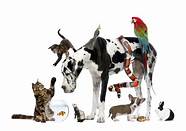How Many Pets in America: A Comprehensive Look at Pet Ownership in the US
Pets have become an integral part of American households, providing companionship, love, and emotional support to their owners. Understanding the prevalence of pet ownership in the United States can help us gain insights into the human-animal bond and its impact on society.

Pet Ownership Statistics in the United States
According to the 2021-2022 National Pet Owners Survey conducted by the American Pet Products Association (APPA):
1. There are an estimated 90.5 million pet-owning households in the United States, representing 67% of all households.
2. Approximately 85.8 million dogs and 58.3 million cats are owned as pets in the US.
3. Other popular pets include freshwater fish (12.7 million), birds (8.5 million), small animals (6.2 million), reptiles (4.5 million), horses (2.9 million), and saltwater fish (1.1 million).
Regional Differences in Pet Ownership
Pet ownership rates vary across different regions of the United States:
1. The West and Northeast have the highest pet ownership rates, with 73% and 70% of households owning pets, respectively.
2. The Midwest and South have slightly lower pet ownership rates, with 65% and 63% of households owning pets, respectively.
Factors Influencing Pet Ownership
Several factors contribute to the decision of whether or not to own a pet:
1. Lifestyle and Household Composition: People living in urban areas or with limited space may be less likely to own pets, while families with children are more likely to have pets.
2. Socioeconomic Status: Pet ownership is more common among higher-income households, as pets can be expensive to care for.
3. Cultural and Personal Beliefs: Some cultures and individuals have strong attachments to pets, while others may view them as a burden or unnecessary expense.
Benefits of Pet Ownership
Pets can provide numerous benefits to their owners, including:
1. Companionship and Emotional Support: Pets can offer love, comfort, and companionship, reducing feelings of loneliness and isolation.
2. Physical and Mental Health Benefits: Interacting with pets can lower blood pressure, reduce stress, and improve cardiovascular health. Pets can also encourage physical activity and provide a sense of purpose.
3. Socialization and Community Building: Pets can facilitate social interactions, helping people connect with neighbors and build a sense of community.
Conclusion
Pet ownership is widespread in the United States, with millions of households enjoying the companionship and benefits of having pets. Understanding the prevalence and factors influencing pet ownership can help us appreciate the human-animal bond and its positive impact on individuals and society.
Declaration: All article resources on this website, unless otherwise specified or labeled, are collected from online resources. If the content on this website infringes on the legitimate rights and interests of the original author, you can contact this website to delete it.




